Attractions in Quindío Colombia
Cocora Valley
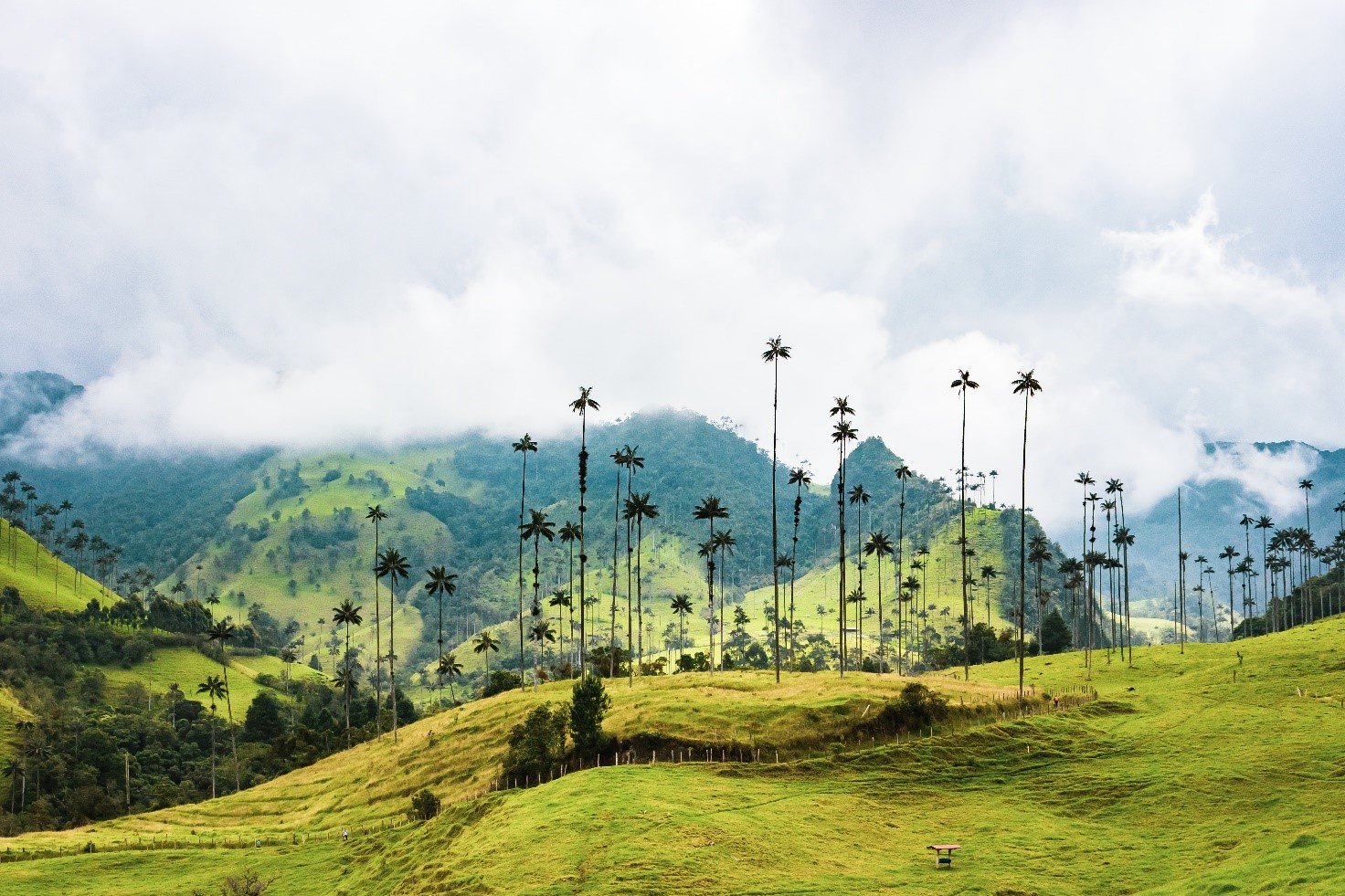
It is located in the Central Cordillera of the Andean mountains and on the upper reaches of the Quindío River. “Cocora” was the name of a Quimbaya princess, daughter of the local chief Acaime, and means “star of water.” The valley is part of a larger national park, the Los Nevados National Natural Park.
This wonderful and incredible place which amazing views of the Cocora Valley and Andean mountains to hike or horseback ride, rafting, scenic flights, mountain biking and swimming in the rivers through lush meadows and green forests; while listening, watching to hummingbirds and wildlife.
The round trail will pass waterfalls, rivers and over more suspension rope bridges. Rest at the top and take in the scenic views before you start descending towards the tall palm trees. The wax palm, native to these lands, grows as high as 60 m (200 ft) and represents the national tree of Colombia. As well as visitor centre and the restaurant near the trout farm serves delicious local specialties and you can find a collection of campsites. The average annual temperature is 15 °C (59 °F), with a maximum of 25 °C (77 °F) and a minimum of 12 °C (54 °F).
Advantage:
- Walk amidst the tallest wax palm trees in the world.
- Multiple walking routes
- Horseback ride is cheap (The expect price is between US$9 to US$30, depends on how much time you desire to spent on the horse).
- There is a little hummingbird reserve/ house at the top of the Valley.
- A relaxed atmosphere with the smell of coffee from the surroundings.
- The cost of every way of share Willy Jeep, fresh local coffee, fee of the entrance, etc., is less than US$2 per person. You expend less than US$10 per person, depend on your necessities.
- You can choose the type of tours shorter and longer on offer.
Disadvantage:
- Go early and know that there will be many people
- The weather is very unstable, if you do not like to get wet, bring a raincoat or umbrella.
Tips:
- Bring food, plenty of water and insect repellent.
- Comfortable walking or running shoes, hat, sunglasses, suncream, a jumper and a towel. if you want to have a quick dip in the water.
- Start the route in the wax palm forest to be able to take a lot of photos of in fairly good weather, until the clouds had descended and there was very little visibility.
Quimbaya Gold Museum
It displays a large collection of interesting history and beautiful pieces pre-Columbian artcrafts, about hundreds gold objects, pottery, stone sculptures, carved woods, with other artifacts and issues, mainly from the pre-Columbian Quimbaya civilization, Embera and some other Amerindian tribes.
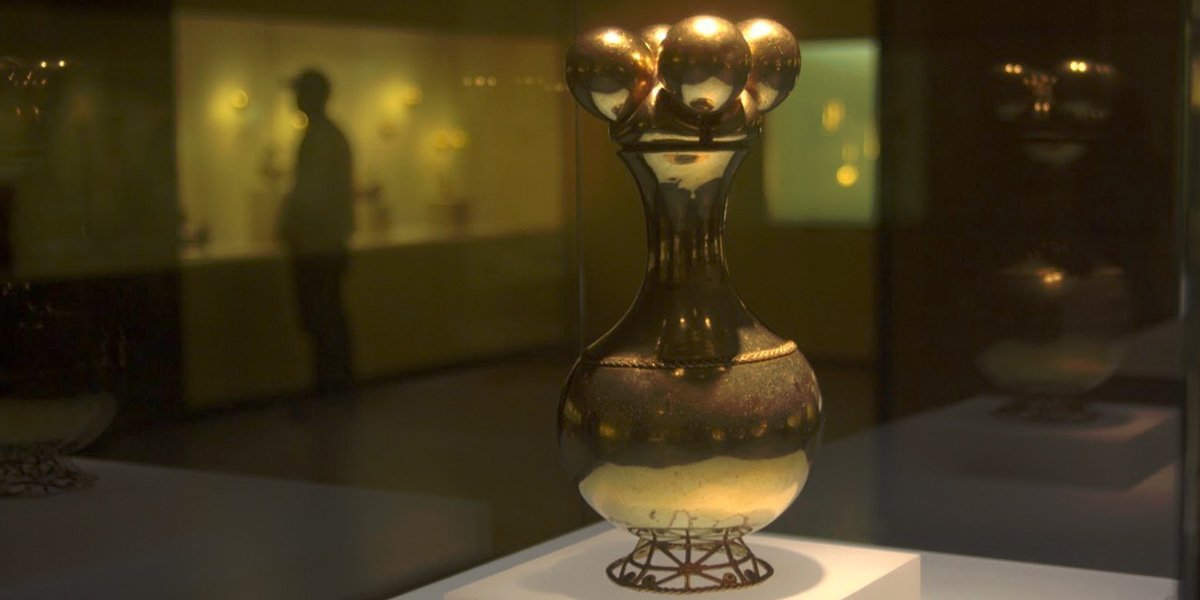
Some of the most important pieces are the gold Poporos (traditional gadgets for the chewing of the coca leaves) and the zoomorphic vases. Most of the pieces have been preserved for experts from Gold Museum of Bogotá. In its exhibition rooms together with her pottery, stone, shell, wood and textile archaeological objects, these items, made of what to indigenous cultures was a sacred metal, testify to the life and thought of different societies which inhabited what is now known as Colombia before contact was made with Europe.
The Bank of the Republic began in 1939 helping to protect the archaeological patrimony of Colombia. The Gold Museum and the Quimbaya Museum are some of its main achievements.
It is located to the north of the city, in front of the locomotive or an old engine from the now-defunct Colombian railroad station, a museum of the first inhabitants of the Quimbaya indigenous culture.
Advantage:
- The entry is free.
- You had the option to take a free tour guide or wander along on your own.
- You can ask for a free knowledgeable guide who kindly will guide and brought you through the history of each piece, artwork and gold crafts to life with his words.
- The building infrastructure temperature is cool inside; in the middle of a beautiful building with awarded design, there is a traditional orchard in the backyard and nice, pleasant and attractive gardens surrounding it.
- The museum is well kept and curated.
- The exhibition has incredibly good explanation with English labels of what their exhibits in a very artistic matter.
- The displays are well thought out, nicely illuminated and the objects are of a remarkably high standard.
- Available public transportation (buses, taxis). The red number one bus on Avenida Bolivar will drop you off out the front.
- Enjoy amazing cultural expressions like story tellers, sculptors worshops, etc.
- The staff is very friendly.
Disadvantage:
- It is crowded on Sunday and closed on Monday.
- The signs are only in Spanish.
- Photos are allowed without flash.
- The museum is small, but the artifacts are captivating in their intricate details. It is small version of the Gold museum in Bogota.
Kasaguadua natural reserve

Kasaguadua Natural Reserve preserves an Andean Rain Forest that extends over 12 hectares of lush mountainous landscape and boasts five natural springs. It is here where both flora and fauna thrive in its natural habitat. Located 2.6km away from Salento, a typical small coffee region town, an hour away from Armenia, the capital of the Quindío region, Kasaguadua Natural Reserve combines conservation with an unforgettable touristic experience such as hike up and down the mountain, sleeping in the deep forest and also the stunning views.
Kasaguadua is a Private Natural Reserve recognized by the Colombian Ministry of Environment and its dependency for National Parks of Colombia. It is part of the regional Network of Protected Areas (SIDAP & SIMAP), monitored by the local Environmental Agency and it is part of the national network of Private Natural Reserves of Colombia – RESNATUR.
Natural Interpretation & Sustainability Tour
The Cloud Forest Tour is 2 hours morning in English/Spanish language and starts at 10 am. The guide shows how this kind of special unique ecosystem functions, the interpretation of sustainability, the different tree types, forest seasons, leaf systems, fungi, seeds, native, the invasive plants and so much more. The animals are mostly nocturnal in the area like white armadillo, lemurs, etc. The cost is US$10 per person.
EcoPODs
It is an innovative Eco Project of the pods with mini–Geodesic Domes building and eco-lodge setup in the nature and/or sustainability. Designed for couples, made using harvested bamboo and recycled plastic. Located 20 metres away from the main Lodge, where all facilities are found, including Toilets, Showers, Kitchen and Living Room.
Advantage:
- Close to the Kasaguadua Natural Reserve just for 10-15 minutes, there is a restaurant with world-class vegetarian food and an unbeatable view.
- It is an easy 30 minutes’ walk from Salento in case you do not want to wait for the Willy Jeep.
- The Guide has an incredible wealth of knowledge such as a lot of insight to share on conservation and environmental restoration about Salento’s cloud forest.
- The people have great sense of hospitality, just to mention Sr Carlos has contagious environmental enthusiasm, he is gusher of information and insight, from biology to ecology to engineering to philosophy. He got a exudes passion for
Disadvantage:
- You cannot come if you are on antibiotics due to the water treatment plan.
Las acacias coffee farm
The Acacias Coffee Farm is a rich and different experience in the world of coffee, it is an Authentic family owned coffee cultivate. You can have the best approach with Colombian coffee culture from the interaction with a traditional family farm. In Las Acacias, you can enjoy the spectacular coffee cultural landscape, get to know crops other than coffee, which are part of the economy of a coffee family, in addition to enjoying a unique setting for lovers of good coffee, served in the best environment and adorned by the best landscape for their photographs.
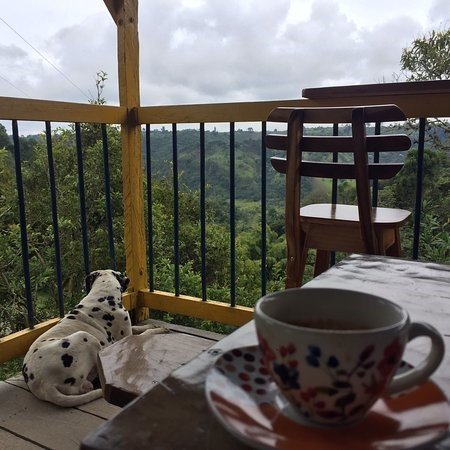
You can appreciate, feel and interact with birds, chickens and the roosters, fruits like berries, vegetables and flowers they were growing. It is a beautiful small ecological farm spreading special charm. Located 40 minute’s walk from Salento, it is wonderful walk with great scenery and amazing places to take pictures; or take a Willy Jeep.
Coffee Tour
The Tour is in English or Spanish language, with 1 hour duration and the entry fee per person is US$5, within a traditional Colombian coffee farm to know and actively participate in the clean farming processes that seek as a final product to obtain a delicious cup of coffee with the best aroma, the best body, and the richest flavours. Our great guides are highly informative, witty and explained very well how coffee farming starts with the planting until drying the beans.
Advantage:
- Free admission for children under 8 years old.
- Free experience of picking their own fruits like berries.
- You will be able to pick and plant some coffee beans on your own.
- It gives great insight into the coffee industry in Colombia.
- You would love to buy bags of coffee to bring to your home and enjoy with a deepened appreciation of the labour and skill that you will go into it.
- You will enjoy on the terrace a cup of the hand selected harvested coffee.
Disadvantage:
- It is 1-hour short tour.
Panaca

It is a farming theme park that promotes contact between humans and nature, intended for those who live in the city and to create awareness about nature. The park was created in Quimbaya, in the Coffee Area of Colombia by a group of businessmen in 1990, and today, is one of the biggest agricultural parks in the country.
The park consists of pavilions dedicated to different aspects of Colombian agriculture. There is a pavilion for cattle, horses, pigs, poultry, dogs, sheep, ostriches, bulls, goats, and a small farmhouse with a sample herb garden. The tour through the pavilions is organized so you stop for a presentation and show about once each hour at the various pavilions. These presentations are very entertaining and informative. The park has horse drawn wagons to help ferry you about if the walking gets to be too much. There is also a huge zipline over the park, you will be impressed by the length and vistas it showcased. There are restaurants catering to different typical dishes, and the food and overall arrangement of the facilities are incredibly pleased with.
The construction is a great innovation and decoration in these areas. Panaca, they are potential rescues street animals and train them for the shows or offer up for adoptions, where the new owners are fully screened as great owners. They look after and kept the animals very well.
Advantage:
- You can watch and feed the ostriches, you would enjoy and have fun doing it.
Disadvantage:
- You will see the way some animals are kept and handled.
In Calarca there are more than fifty farms and other accommodations that offer comfortable stays so that you do not miss the nights of natural murmurs and the beautiful sunrises in the midst of rural beauty. In that sense, the Santa Helena farm, located on the Callelarga sidewalk and bathed by two rivers, offers unparalleled attention and great experiences such as kayaking, bird watching and one of the most spectacular views in the area.
Jets of san Rafael
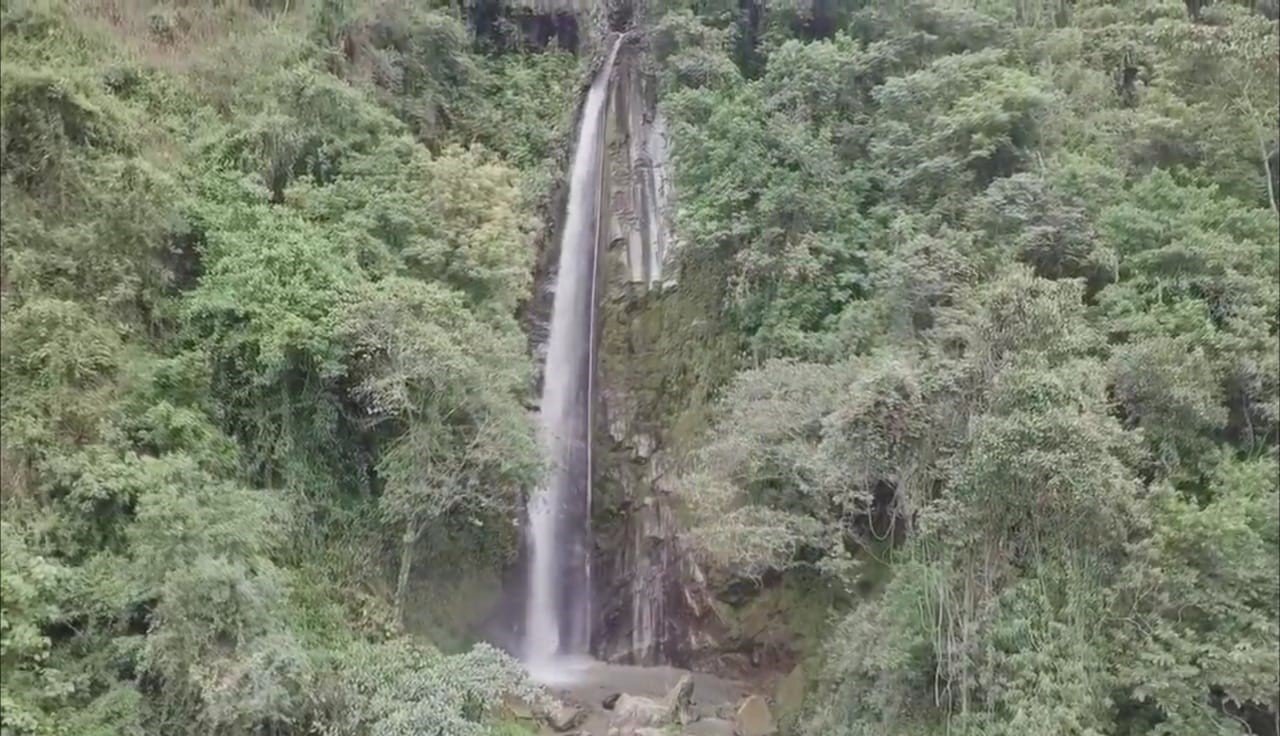
Among its natural attractions it is worth mentioning the Chorros de San Rafael, a pure waterfall of 50 meters; the Cerro del Castillo where paragliding is practiced repeatedly; mountainous elevations that offer beautiful views such as La Divisa, Alto de La Línea, and Alto del Campanario. Now, if we talk about geological formations, Peñas Blancas, which can be seen even from Armenia, gets all the praise. This eco-park is the favourite for those who want to know more legends of the Calarca cacique and his hidden treasures, while having the opportunity to climb and speleology.
One of the undiscovered treasures in Calarca, are undoubtedly the San Rafael jets, waterfalls that descend from the mountains and fall into the Santo Domingo River, which runs almost parallel to the road to La Linea and is a very important part of the water and environmental supply of Calarca, surrendering its waters to the Río Verde.
The 7-kilometer journey begins in the gallery, taking a Jeep that, for an exceptionally low price, takes you to the Las Aguas or Santo Domingo Bajo path, passing by the old slaughterhouse near the so-called Red Bridge.
The road ends abruptly near the Los Balsos farm, since, last winter, the Santo Domingo river grew so much that it prayed over the road bench and collapsed it, also endangering one of the main pipes of the aqueduct which, in more than 300 meters, it is naked and in parts suspended dangerously threatening to collapse, which would put the city in serious water supply problems.
Finally, it is worth mentioning that any date is excellent to visit Calarca, however, if you come at the end of June, the fun increases significantly in the National Coffee Festival, one of the most emblematic celebrations in Quindio that, among many things, it will surprise you with its original “yipao” contests.
Filandia
It is located to the North of the department along the Coffee Motorway from which you must turn left at km 20 and then take a paved and narrow road of about 7 km. This last section is made between farms and the nature reserves of Bremen and Barbas, which at the same time create a very striking landscape environment for its greenery and fertility. The place is on a plateau, a location from where you can see several of the bordering municipalities.
The friendly character of the residents is charming, many of them coffee growers, the first product of the municipality and forging reason of the culture that is lived in all its corners. The peasants, at the end of their days, congregate in the square to share experiences with insiders and outsiders.
Tourist Attractions of Finlandia:
Quindío Illuminated hill viewpoint
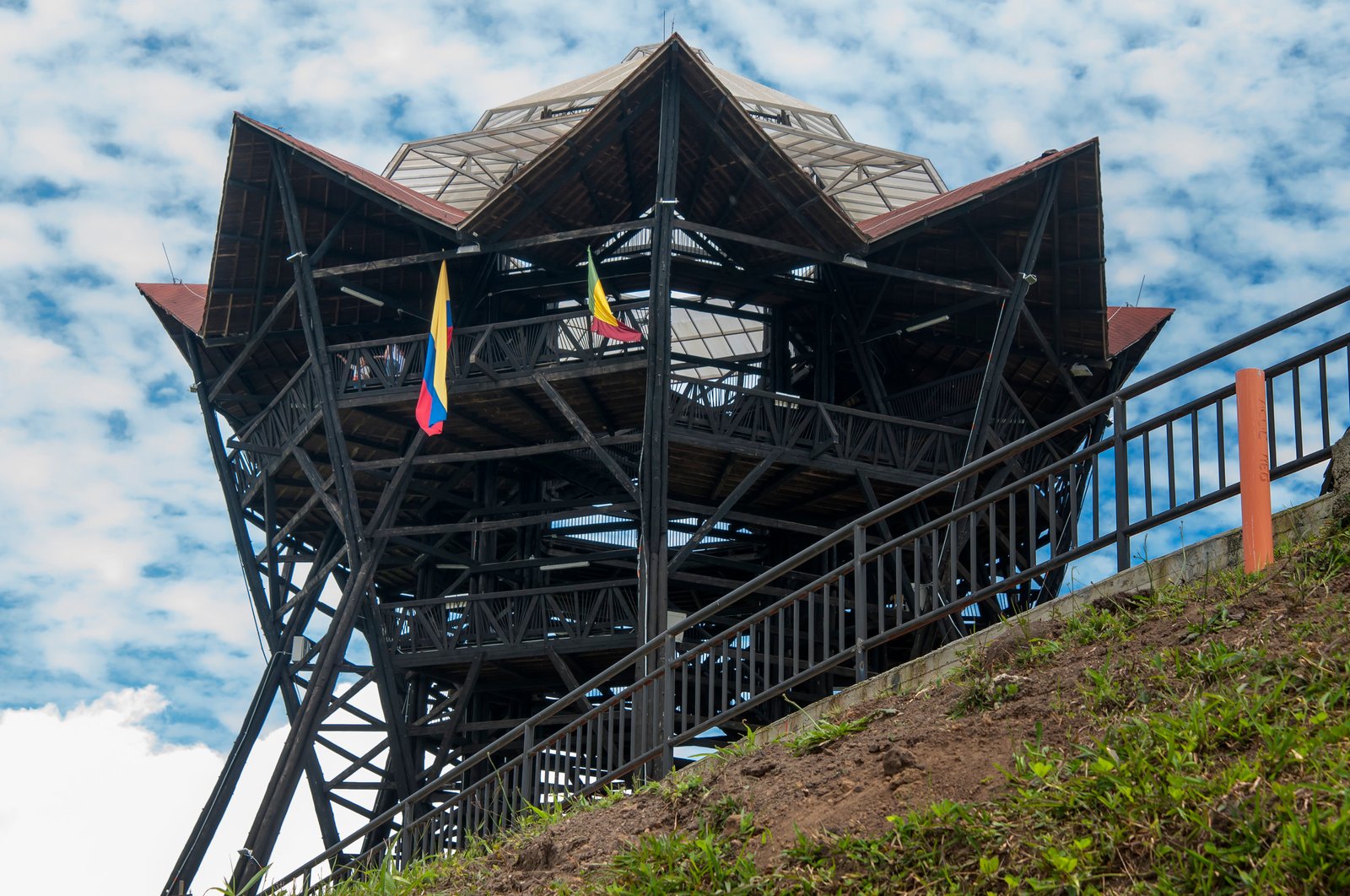
It was built in mangrove from the Caribbean and other woods from the region such as zapan and macana. It is a tower erected on the slopes on the outskirts of the town on the road that leads to Quimbaya, representing the ideal place to observe the panoramic view of Finlandia and 360° of beautiful landscapes. On clear days you can see almost all the towns of Quindio, the city of Pereira in Risaralda and some towns in the north of Cauca Valley (Spanish: Valle del Cauca). The viewpoint has a height of 27m and is the result of an effort by the Quindio Government that promoted the execution of the work to take advantage of the geographical characteristics of the municipality.
It has several balconies for viewing the landscape and a Coffee Bar that is open on weekends. Additionally, on the interior floor of the tower, the figure in pieces of glass and mirror of a blue butterfly stands out, whose view from the top is as striking as the panorama that surrounds the viewpoint. You can visit any day, but weekends and holidays are the busiest.
- Central park of Finlandia
Main destination where the natives of the town, the travellers, the muleteers and the Yipaos converge. Here there are paths between gardens and benches, and some kiosks where they sell refreshing natural juices, fruit salads and salpicones (salpicon is a mix of small pieces of different types of fruits with juice in it). In the surrounding blocks you can see beautiful houses of the first settlers, there are several Coffee Bars and some restaurants
- Immaculate Mary temple
With some repairs, this temple was built essentially using the bahareque technique and with cedar and laurel wood, materials that can be appreciated inside and in the sequence of columns that characterize it. It stands out since 1905, the year of its foundation, next to the main park and on seventh street
- Architectural Ensemble
Time Stopped Street, North of the central square, took its name because the houses that are next to it, except for the necessary repairs, have been kept in their original structure and appearance. Along with the buildings that stand in the blocks of the central square, these traditional houses are considered a valuable sample of the Antioquia legacy that prevailed in the founding of the towns. The Bethlemitas College also stands out with its extensive corridors and balconies, the institution is a faithful reflection of the architectural style imposed by the former colonizers. The Architectural Route, of which Finlandia is a part, is a tour through the municipalities of Calarca, Salento and Pijao that the visitor should not miss.
Quimbaya
In the urban area, the old houses with balconies and chambranas left by the colonizers are combined with some constructions, product of the evolution of the town. In the Central Park, the yipaos pass and park as a permanent sign that they are in a typical town in the Coffee Zone. The streets and the Quimbayas square are a meeting point and an obligatory step towards the attractions of the region, such as the Panaca National Park of Agricultural Culture.
Attractions:
- Momma Lulu’s little farm
In the environment of agricultural crops and domestic fauna, a family from the region designed this self-sustainable project where food is produced for the daily consumption of the inhabitants of the house and those who visit them, attracted by the interest of knowing how to live with sufficiency in the field. The integral farm facilitates the services of lodging, restaurant and educational talks given by the hosts on ecological and agricultural issues.
- Rafting
It is one of the activities overlooked by visitors to Quindío, a pioneering region in Colombia with this kind of navigation that emulates the mobilization by the river that the ancient indigenous people did. The plan begins in the town of Quimbaya, usually aboard a classic Willys jeep to Puerto Alejandría, the embarkation point. With life jackets and experienced rowers, a placid and exciting experience begins on the rustic rafts made of guadua, in the navigable stretches of the La Vieja river. The activity of the rafting allows to know one of the main Quindian rivers and the abundant vegetation that frames it. In Quimbaya you must ask about the companies organizing the plan, which generally includes transportation in yipao, the loan of safety accessories and cold cuts, a typical local lunch served in banana leaves. The duration of the tour is up to four hours.
- Candles and lights Festival in Quimbaya
The traditional night of the candles and the party in honour of the Virgin of the Immaculate Conception are the main reason for all the families of Quimbaya to manifest with ingenuity during the festive, cultural, and religious event that takes place on the days December 7 and 8 of each year. During the festival, the town is filled with light and colour thanks to the thousands of lanterns made of cardboard, paper, glass, and ceramics. The residents of each block form a single team to create a common lantern design and thus participate in the contest that ultimately rewards the most original and colourful street. If your trip is in the last month of the year, be sure to attend this solemn and at the same time Joyous celebration. The lighting in Quimbaya is one of the main tourist attractions in Quindio. If you are lucky enough to be in the Coffee Axis (Spanish: Eje Cafetero) on December 7 or 8, do not miss this celebration.
